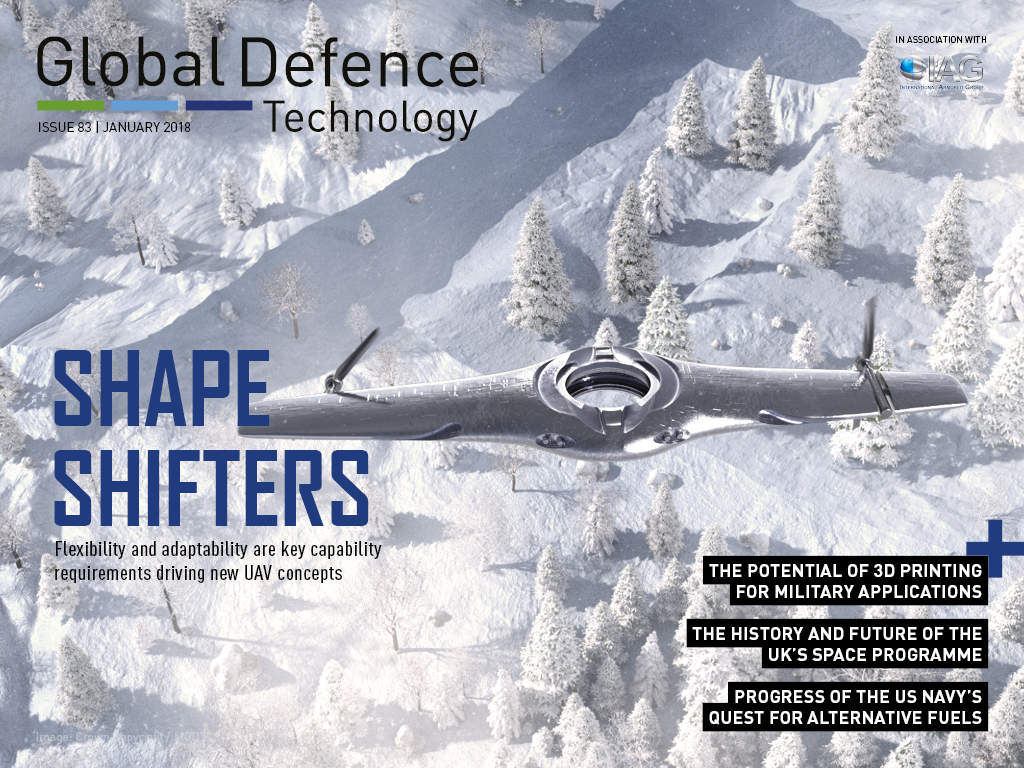
Innovation in UAV technology keeps racing ahead, with new concept emerging in a steady stream. We take a look the latest developments in unmanned aircraft, including am “adaptable” concept from BAE Systems and Cranfield University, and Martin UAV’s V-Bat, a vertical take-off and landing drone.
Also in this issue we explore the potential of 3D printing for military applications and take a look at pioneering projects, find out how smart sensors embedded in helmets could help to prevent hearing loss in the future, and review key milestones and new investments in the UK’s space programme.
Plus, we ask what a potential merger of Fincantieri and Naval Group would mean for the shipbuilding sector in terms of business opportunities and global competition, and catch up with the US military’s efforts to reduce its reliance on fossil fuels at sea.
In this issue
Made to Measure
No longer an expensive niche process for prototyping, 3D printing has joined traditional manufacturing methods as a go-to technique for producing military technology. Its importance was highlighted when funding for it was earmarked in the 2018 US military budget. Berenice Baker examines recent projects to find out more about future military applications for 3D printing.
Noise Control
Researchers at Nottingham Trent University are using sensors embedded in textiles to measure and record the levels of noise which soldiers experience. Claire Apthorp finds out how they work, and how they could help prevent hearing loss.
UAV Innovation
Unmanned aerial vehicles (UAVs) have come a long way since their first deployment, passing from oddity to a commonplace operational necessity. As one of the hottest areas for R&D, manufacturers and defence departments are focusing on perfecting flexibility, endurance and autonomy, as Dr Gareth Evans reports.
A Journey through Space and Time
The UK’s Defence Science and Technology Laboratory has launched a £50m space innovation programme. Berenice Baker explores two key projects that will benefit from the funding and takes a tour of the history of British space innovation from the space race to the near future.
Fincantieri & Naval Group: Assessing Potential
By June 2018, if things go as expected, a merger between Italy’s Fincantieri and France’s Naval Group could see the birth of a new European giant in the sector, a move that would have major ramifications for Europe’s defence landscape and the global naval industry as a whole, as Dr Gareth Evans reports.
Going Green at Sea
Bold and aggressive moves to cut down the US Navy’s vast energy footprint are beginning to show dividends. So is the Navy on track to clean up its act? Dr Gareth Evans finds out.
Next issue preview
From tiny swarms to gigantic gliders and the US Navy’s new extra-large unmanned undersea vehicle, the rapid evolution of UAVs has resulted in a huge diversity in shape and size. We take a look at the most interesting designs coming out of R&D labs around the world.
Also in the next issue, we visit Cranfield’s Centre for Defence Chemistry to find out how its explosives specialists work on all aspects of defence manufacturing, vulnerability, combustion, and life assessment of energetic materials, and deliver training for the MoD. We also check in on the latest in energy-efficient bases, and explore new applications for driverless vehicles. Plus, we speak to Lockheed Martin about its work on the US Air Force’s jet-based laser weapon, and take a look at BAE Systems’ plan for a digital shipyard in Adelaide.



